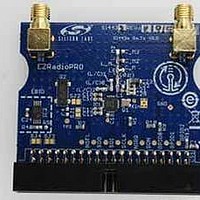4432-DKDB1 Silicon Laboratories Inc, 4432-DKDB1 Datasheet - Page 17

4432-DKDB1
Manufacturer Part Number
4432-DKDB1
Description
WiFi / 802.11 Modules & Development Tools Tx/Rx Split 4432 TRx Testcard Hi band
Manufacturer
Silicon Laboratories Inc
Datasheet
1.SDBC-DK3.pdf
(76 pages)
Specifications of 4432-DKDB1
Modulation
GFSK
Operating Voltage
3.3 V
Antenna
SMA
For Use With/related Products
Si4432
Lead Free Status / RoHS Status
Lead free / RoHS Compliant
It can be seen from Table 3 and Table 4 that while the effects of antenna diversity on LOS environments are
negligible, the benefits in indoor/urban environments can significantly help create robust, higher quality robust
links.
The Self ID on each card should already be selected and is contained in the EBID eeprom on the testcard. The
EBID is placed on the testcard so that our firmware and support GUI's (such as WDS) can recognize the
characteristics of the board. The EBID is NOT required as part of the bill-of-materials in an end customers design.
The EBID contains information such as the local ID, destination ID, matching network configuration and antenna/
test card configuration type.
The SDBC-DK3 is initially configured with the same value for the destination ID and the self ID. In order to run the
demo, you will need to configure the destination ID of the first board to that of the second and vice versa. This will
allow the two SDB boards to communicate with each other. The ID is considered the address.
7.1.5. Packet Length
The node parameters screen also allows users to adjust the packet length so that they may:
1. Perform head-to-head comparisons with competitive radios
2. Learn the effects of packet length with respect to data-rate and robustness
Many things affect the robustness of a radio link and often the lack of understanding of some of these variables can
skew test results quite substantially.
A good example of when this misunderstanding takes place is during head to head comparisons of different radio
IC suppliers. By using the 'packet length' option in the menu, users may adjust the length of the packet to match
such that they are looking at the same packet structure during their tests. (See section 7.7 for further details on the
packet structure)
Once designers are satisfied with their head-to head comparisons of the radio IC's having based their tests on
similar structures then designers can use the packet length option to experiment with their protocol. Packet length
can have many tradeoffs with respect to power savings, robustness, data rates, processing overheads, etc.
Figure 19. Screen 4: Setting Up the Node Parameters
Figure 20. Test Card Characteristics EEPROM (EBID)
Rev. 0.4
SDBC-DK3 UG
17













